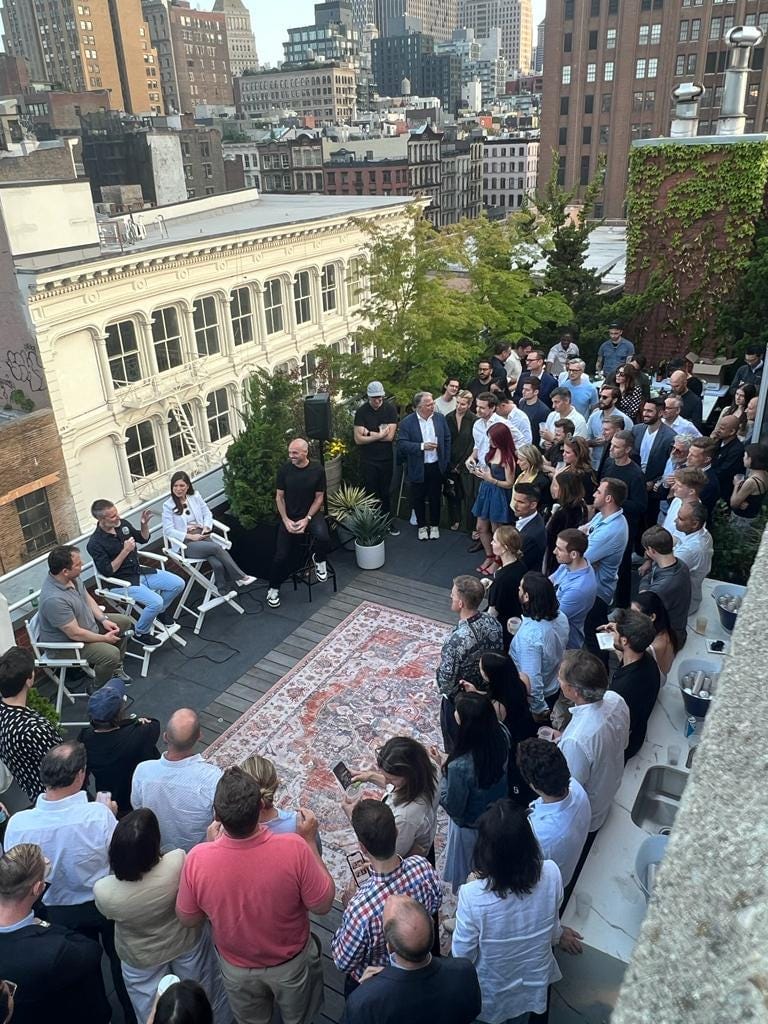The labor-capital-tech nexus
Old playbooks rarely work on future challenges

Final call for Cannes: If you’re heading to the Riviera, please join us at one of the events The Rebooting is holding. Should be a great week. We’re publishing a daily newsletter from Cannes that I promise won’t be boring recaps of stultifying panels. Thanks to Kerv Interactive for its support to make that and The New Attention Economy happen.

How Questex used Omeda to drive nearly $6m in ad revenue

Generating revenue from content has never been easy. But the rise of digital has only complicated the issue: Advertisers need to optimize their strategy and content for a growing number of platforms all while competing with a growing number of creators, publishers, and businesses.
To drive revenue from their content, Questex used Omeda’s CDP, marketing automation solution and database tools to create content channels, a package that allows advertisers to “own a topic” on Questex’s digital channels and reach the Questex audience on email, social, and other platforms.
Not only has Questex driven nearly $6 million in revenue from this campaign, but they’ve driven 53% more rebookings from advertisers and created a stable source of income moving forward.
The labor-capital-tech nexus
Many of the issues confronting us are complex and defy easy solutions. One of the biggest reconfigurations is the relationship between capital and labor in an age of technology. As Ian Bremmer says, “There's a third that is coming soon that's even more important. And that is the digital order. And the digital order is not run by governments but by technology companies.”
The mania over AI has all the hallmarks of a gold rush – much money will be made and lost, that’s for sure – but also a profound shift in not just how we access information and manipulate data but how we order societies. Tech is relentlessly disruptive to legacy companies, always deflationary and a great commoditizer.
The merciful end of the increasingly vicious and ludicrous Insider strike shows this clearly. The nearly two-week strike ended a multiyear battle over Insider’s unionization, one of several that have happened across the digital media industry as workers look to claw some protections in an industry that, to put it mildly, has been a rollercoaster for as long as I’ve been in it. My first journalism job, in 2000, lasted all of 18 months before I was AIM’d into a conference room and laid off with three weeks severance by one of the All-In podcast guys. We at least went to Rudy’s for beers and free hot dogs afterwards. Welcome to journalism, where you can be called The Establishment and still have roommates in your 30s.
The need to rebalance the relationship between capital and labor is driven by inequality. I don’t care if economists can “well, actually” and point to charts that show overall inequality declines, the cubicle worker class does not feel that way. They mostly were born middle-or upper-middle class and believe they will have worse economic outcomes than their parents. The inequality of society exists within companies, of course. In the United States, CEOs make on average 400 times more than the average employee at their firms. This is a feature, not a bug, of shareholder capitalism as practiced in the United States. That inequality filters down. The pandemic brought it home even more, as the Boss Class decamped for their second homes in the Hamptons and the Hudson Valley as the Cubicle Class made due in their apartments or, worse, back with their parents.
The ultimate deal to the Insider strike as reported seems sensible. A $65,000 salary floor seems realistic. (I made the equivalent of $70,000 in my first journalism job in 2000.) Even more so since Insider CEO Henry Blodget is on record believing companies should pay their workers more because it was great for the economy, which is powered by the middle class spending money. The headline is also Classic BI, my preference: “Sorry, It’s Not A ‘Law of Capitalism’ That You Pay Your Employees As Little As Possible.” Health care is a mess and companies shouldn’t be on the hook to provide it in an advanced society. The promise not to lay anyone else off this year will be a delaying tactic. I’ve seen no evidence in digital media that unions have been able to reverse the reality of economics. BuzzFeed’s union didn’t make that a more sustainable business. Vox’s union didn’t stop it from shedding 130 jobs earlier this year. And so on.
The Insider fight veered into the personal with repeated attacks on Insider management by frenzied union activists. Thankfully, people just got blocked on Twitter and LinkedIn; nobody got kneecapped with a led pipe or outfitted for cement shoes. Unionization in digital media means marching around the kati roll trucks in Zuccotti Park and al fresco pizza lunch, not warming your hands over oil barrel fires and brawls at the factory gates. The Revolution will be memed.
Maybe Insider EIC Nich Carlson got off easy by just having to Citibike around to take down fliers in his Brooklyn neighborhood painting him as a greedy “millionaire.” (Not sure that’s going to go over well in that part of Brooklyn, where many, many people are millionaires and beyond. This place is insanely expensive.) I have to admit Elon Musk had a funny response to the strike: “Fight on, comrades!”
I was struck by the immaturity of it all. How do you go back to Bagel Friday after all that? How do you work together productively in such an adversarial environment? And to send the video of Nich being set upon by his colleagues to The New York Post takes the cake. It had Cultural Revolution meets a particularly fraught student council election vibes. This has all the maturity of toilet-papering the neighbor’s trees on Mischief Night; I assume most of the members of Insider’s union know this, based on what Daily Beast reports. Nich is just doing his job as management. It’s literally the job, to put it in Gen Z.
And of course, management chose to string along the union and delay, delay, delay. The anti-union consultants, like all consultants, run the same playbook time and again. Delay and obstruct, try to wear down the union and split them. Maybe it’s worth it; I can’t imagine it will be in the long term considering the organizational chaos and damaged morale while Insider faces a rough ad economy and getting caught in-between on subscriptions.
There are productivity gains to more satisfied employees, for sure. But unions are uniformly seen by CEOs as a regulation. I have not met a media CEO who in private does not despise the prospect of unions, no matter how progressive they are on Twitter with various popular causes. The arguments are familiar: they create an adversarial work environment and serve to slow down the rapid shifts companies need to make at a time when tech dictates the path companies take. This isn’t a great time to be ideological.
These battles are about the size of the pie, not growing the pie. Right now so many things that were, if not home runs, solid doubles for the business aren’t working. People are missing numbers, and it’s against a fairly resilient economy. So when publishers are putting up revenue declines but ad holding companies are seeing growth, there’s a deeper reason than the normal gyrations of the ad market.
But those are unlikely to do much when put up against the set of challenges facing these businesses, not just in the near term with an ad market that’s growing but away from what these publishers do. Not a great time to have a pageview model.
GroupM painted a healthy picture for ad spending, but the growth is coming in areas like retail media and CTV. Putting words on webpages and making money from display ads is not a growth industry. The Mary Meeker slide is no longer trotted out for a reason. The scale models were based on producing page views relatively cheaply. Henry used to show this chart about how much more “efficient” BI was compared to the NYT. He predicted the New York Times would need to drastically reduce the cost of the newsroom in the transition from print to digital; there’s a new transition that will take place and those same pressures will be even more intense.
Labor is the biggest input cost in media businesses. Doesn’t take a labor economics laureate to understand that cheap labor has been a critical feature of these models. Media companies send middle-aged workers to the glue factory once they get too expensive because they want to own a home and send kids to college. In the previous era of digital media, you’d never be in more demand than as a 25-year-old.
The career path in journalism was always to claw your way into some management job that mostly involved pushing around copy and sitting in meetings. That’s hardly a safe haven, since I’m regularly speaking to middle aged execs who ended up farmed out when they got too expensive. If you think media companies treat workers as expendable when they’re making $75,000, wait until you see the experience when you’re making far more of that. I was speaking to an exec suddenly cut loose after nearly two decades, and he remarked that he understood why: He was a big salary on a spreadsheet. In the end, workers are just that: numbers on spreadsheets.
I don’t see unions changing that dynamic for these models. The question is whether you fight to reform the old model or exit to create a better model. The overall trend across industries is the rise of individuals who create outsized impact sharing more of the rewards. Messi is hardly an employee of Inter Miami.
We’ll see more people opt out of that to take an independent path and build a life of autonomy or join smaller organizations in which they are more than “just” employees by developing deep expertise and what used to be called a reputation and now is unfortunately termed a personal brand. AI tools will turn the competitive advantages of scaled organizations into millstones better to be small and nimble than big and lumbering. Puck’s partnership model feels directionally right. Or even Every’s collective model or Workweek’s creator approach. Better to be talent than a worker or middle manager.

Programmatic Insights with Burt Benchmarks
Burt Intelligence is your go-to platform to analyze and optimize advertising data. Register now to watch the replay and download the slides of our programmatic insights webinar from yesterday to gain access into programmatic strategies, benchmarks, and best practices that will increase your advertising revenue. Watch the replay and download slides.
AI + Media Salon

On Tuesday night, I joined Human Ventures’ Joe Marchese, Sara Fischer of Axios and Vox’s Peter Kafka for a conversation and gathering devoted to media in an AI era. Thanks to Joe and Christie for hosting us. Let me know if you’re interested in future events that The Rebooting has planned for fall.
Picking a lane in media
On this week’s episode of the People vs Algorithms podcast, Troy Young and I consider the divergent paths taken by The New York Times and CNN. The Times is held up as perhaps the biggest success case of a legacy media brand reorienting its business for a new era. We contrast that with the travails of CNN, which is in the early days of navigating a path of change as the subsidies of the cable bundle expose weaknesses of its model that’s been very lucrative for a very long time.
Thanks for reading. Send me feedback by hitting reply.
To work with The Rebooting, check out our sponsorship overview and get in touch.




